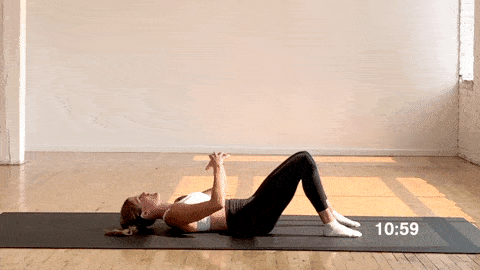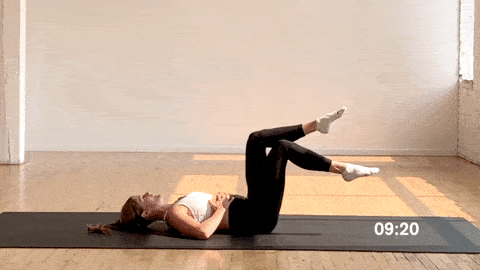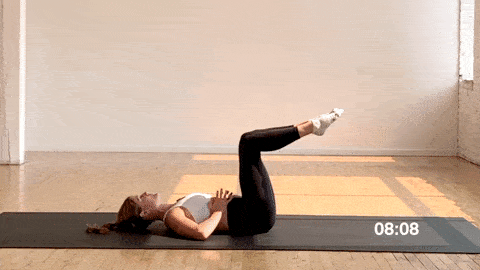
Diastasis Recti is a condition that is common especially after pregnancy but a lot of people are unaware they have it. It’s not something that’s life threatening but it could make everyday life uneasy. There are several nicknames for this condition like ‘mummy pooch’. It is particularly common postpartum.
According to Barts Health NHS,
While you are pregnant, your abdominal (six-pack) muscles stretch to allow room for your baby to grow. Diastasis rectus is when these tummy muscles over-stretch during pregnancy and separate down the midline.
How To Check For Diastasis
According to NHS, here are steps to follow to check if you have Diastasis:
- Lie on your back with your knees bent and feet flat on the bed. – Gently raise your head and shoulders off the bed.
- Place fingers vertically into the gap in line with the belly button. If you can fit more than two fingers into the gap, you have diastatsis.
- If the gap is two fingers or less follow the exercises and advice in this leaflet.
*It will be worth referring yourself to a physiotherapist or osteopath.
Symptoms Of Diastasis
According to Healthline, symptoms include:
- A pooch or bulge in your stomach, especially when you strain or contract your abdominal muscles.
- lower back pain
- poor posture
- constipation
- bloating
Irrespective of what you weigh on the scale or what size you wear, anyone can have Diastasis.
I was very unaware of what this condition was after giving birth. Between giving birth and dealing with the physical, emotional and mental trauma of my pregnancy, figuring out something called Diastasis – which was part of the cause of the severe back pain I had been experiencing, was just another icing on the cake. As a first time mom, it was extremely overwhelming.
After seeing my doctor and being referred to an osteopath, I was examined and told about diastasis. The road to recovery was not so easy but it got better. I was educated on everything from posture to exercises, how to manage and ‘repair’ the stomach walls.
Personally, in my first attempt trying to even lift my legs, I thought I was carry a house on my lower body and my whole vagina was about to fall out. Yep! The most important thing is to go easy, celebrate small wins and breathe!
Pilates and Yoga play a huge role in helping and treating diastasis. Initially, I was always weary of the amount of effort they required but with consistency and dedication, I have come to love them. They are also one of the safest exercises to do especially postpartum. Do not be deceived by how easy they look without trying them; they are the definition of ‘don’t judge a book by its cover’.
A lot of the exercises that you see online for diastasis have pilates incorporated in them, even if the trainer may not state so.
I found that the exercises I used for diastasis also helped me with pubis symphysis dysfunction aka pelvic girdle pain I was diagnosed with, which was another crazy ride. Postpartum stage is as important and possibly almost more important than pregnancy stage because after our body has been stretched way above its limit, the recovery stage will take as much time and quite frankly much longer. It’s important to go easy and be very kind to our body. This is an overstated statement but it is really important.
Now, postpartum execerises should be low impact at the initial stage and must be approved by your doctor before starting anything.
In collaboration with Lindsey of Nourish Move Love, here are six low impact exercises that you can use to help heal diastatsis.
Lindsey is a Certified Personal Trainer, Group Fitness Instructor, Certified Fitness Nutrition Specialist, Pre/Postnatal Training Specialist, Prenatal Yoga and Barre Training Specialist.
Nourish Move Love
- Transverse Abdominal Breathing + Core Connection
Targets: the deep transverse abdominal muscles (TVA) and pelvic floor muscles. These muscles support your internal organs, your inter-abdominal pressure system, and provide stability an mobility of your lower spine.
- You want this entire movement to come just from your belly.
- Hold the inhale for 1 second, and then slowly begin to exhale. Exhale, as much as you possibly can over 5 seconds, while pulling your belly button down towards the mat. Focus on squeezing your TVA muscles, posteriorly tilting your pelvis, in the exhaled position.
2. Lying Bent Knee Pulls
Targets: transverse abdomen, lower abs and hips.
- With your low back pressing firmly into the mat and your abdominal wall wrapped as tightly as possibly around your core, alternate pulling one knee towards your chest.
- Hold knee to chest for a 2-3 count and switch legs.
To modify, keep your extended leg on the mat.
3. Elevated Bent Knee March
Targets: transverse abdomen, lower abs and hips.
- With your low back pressing firmly into the mat and your abdominal wall wrapped as tightly as possibly around your core, bring your legs to a 90 degree bend.
- Note, the closer your knees are to your chest the easier this ab exercise will be. The farther your knees are from your chest, the harder this Diastasis Recti exercise will be.
- Alternate tapping one toe towards the ground, return to starting position, and tap the other toe towards the ground. This movement is slow and controlled.
To modify, keep both toes on the ground and alternate lifting one knee towards your chest and switch.
4. Elevated Leg Extension + Leg Drop
Targets: transverse abdomen, upper abs, lower abs and hips.
- With your low back pressing firmly into the mat and your abdominal wall wrapped as tightly as possibly around your core, bring your legs to a 90 degree bend.
- Note, the closer your knees are to your chest the easier this ab exercise will be. The farther your knees are from your chest, the harder this Diastasis Recti exercise will be.
- Alternate extending one leg straight out, then slowly lowering the extended leg towards the ground.
- Return to starting position, and repeat on the other side. This movement is slow and controlled.
To modify, take out the leg lower and only perform the leg extensions.
5. Elevated Leg Extension + 2 Circles
Targets: transverse abdomen, upper abs, lower abs and hips.
- With your low back pressing firmly into the mat and your abdominal wall wrapped as tightly as possibly around your core, bring your legs to a 90 degree bend.
- Note, the closer your knees are to your chest the easier this ab exercise will be. The farther your knees are from your chest, the harder this Diastasis Recti exercise will be.
- Alternate extending one leg straight out, then slowly draw two donut-sided circles with the big toe of your extended leg.
- Return to the starting position, and repeat on the other side. This movement is slow and controlled.
To modify, perform one circle or take out the circles and only perform the leg extensions.
6. Elevated Bent Knee V-Taps (2 count on the way down and up)
Targets: transverse abdomen, upper abs, lower abs, hips, adductors and pelvic floor.
- With your low back pressing firmly into the mat and your abdominal wall wrapped as tightly as possibly around your core, bring your legs to a 90 degree bend.
- Note, the closer your knees are to your chest the easier this ab exercise will be. The farther your knees are from your chest, the harder this Diastasis Recti exercise will be.
- Maintaining the 90 degree bend in your legs; open both legs, lowering your toes towards the outside of your mat on a 2-count.
- Tap your toes on the outsides of your mat, then return to the starting position on a 2-count, squeezing your knees and inner thighs to touch as you return. This movement is slow and controlled.
To modify, drop only one leg to the outside of the mat and return to the starting position, then dropping the other leg. Alternating legs versus dropping both legs at the same time.
Here is also a full video with the exercises discussed above:
For more extensive tips and resources, visit Nourish Move Love.






